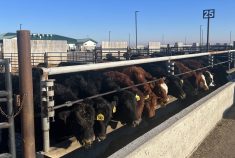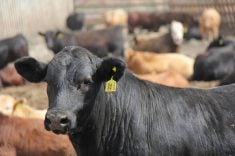It could be our next BSE
It is time to take what we have learned from BSE and apply it to Johne’s disease (JD).
Johne’s is different from BSE. It is caused by a bacteria, Mycobacterium avium, subspecies paratuberculosis (MAP), not a lifeless prion, so it can be killed. Rather than attack the brain JD is a contagious, progressive bacterial infection that causes abnormal thickening of the lining of the intestine, restricting the absorption of nutrients. Infected animals develop long-lasting diarrhea and waste away.
Read Also

Building demand together: The impact of Canada’s beef import levy
The beef import levy has become a central tool for ensuring balance in Canada’s beef industry
Like BSE, MAP generally infects animals at a young age. Symptoms are not seen for years after infection and most infected cows never show signs. Infected animals may appear normal and spread the disease to other animals in the herd before showing signs themselves. In short, it is a hard disease to spot, so it spreads easily from farm to farm.
The bacteria is passed on udders, feed, water or manure. It doesn’t multiply outside the cow but survives in manure, water and pastures for a year or more.
This is a nasty cattle disease. It can be killed, but is difficult to detect making it hard to control. It can wreak havoc when it settles into a herd. But its real danger, like BSE, is what it could do to our markets for cattle and beef.
Johne’s may be linked with Crohn’s disease, an incurable, chronic, intestinal disorder in humans. If this link is ever proven, beef and milk may be viewed as a route of disease transmission to humans, and borders may start shutting down again.
That’s why you will be hearing more and more about Johne’s control, if not eradication in future. Canadian industry and governments have now set up the Johne’s Disease Initiative to raise awareness about this potential threat and take steps to reduce the prevalence of the disease across the country.
It is voluntary, but everyone is involved whether they want to be or not. We simply cannot afford to even contemplate another trade-limiting disease within our borders. This is a national initiative but it’s driven by the provinces. Several have already started up programs to get people informed, and the others are moving quickly to catch up.
Wherever you live you can make a commitment right now to get involved and at a minimum, whenever possible, apply the best management practices that have been adopted to check the spread of this disease. The full list of best practices is available on the web at http://www.animalhealth.ca/CJDI.In the meantime, here’s a short list recently put out by the Canadian Cattlemen’s Association.
Raise uninfected replacements
Do not keep replacement heifers from dams showing clinical signs of JD.
Avoid exposure to infected animals and manure
Separate weaned calves and yearlings from mature animals and from their manure. Raise replacements in separate pastures and/or separate pens.
Avoid using common feeding and water sources when possible.
Pay attention to manure drainage through barns, corrals and yards.
Prevent manure drainage from cows to weaned calves and yearlings.
Fence off bogs and sloughs to prevent access to manure-contaminated run-off. Minimize vehicle and people traffic to areas containing young animals.
Do not allow weaned calves and yearlings to graze on pastures used by cows within the last year.
If there are many infected animals, consider segregating the herd into infected and non-infected areas.
Scrape pens as needed to remove cow manure.
Haul cattle in clean trailers.
Prevent contamination of feed and water with the JD bacteria
Use separate equipment for feeding and manure handling.
Avoid feeding on the ground—use raised feed bunks and waterers.
Prevent manure buildup around waterers. Do not use common mangers/bunks for replacements and mature animals. Do not walk through feed areas/mangers with dirty boots.
Quickly remove and clean manure out of mangers and bunks.
Keep animals out of mangers and bunks. Do not feed refused feed from cows to young stock or replacement heifers. Do not allow young stock or replacement heifers to graze a pasture the same season after manure application.
Prevent the spread of JD due to infected mature animals
Eliminate high-risk animals.
Separate and cull clinical animals immediately (do not sell to another producer unless they are told of reason for culling). Thin, weak, late-stage cases should be humanely euthanized on farm. They are unfit for transport and should not be loaded or hauled for any purpose. Cull all offspring and test dams of confirmed cases.
Use homegrown embryo transfer recipients—do not purchase embryo transfer recipients from unknown sources or auction barns.
Avoid exposure to other JD-susceptible species with unknown status (e. g., sheep, goats, farmed deer or wildlife).
















